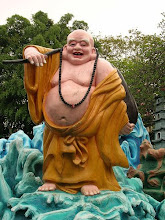
In 1963, he sat down in a street in Saigon in the meditative position. He poured gasoline all over his body and set himself alight. He maintained a calm and meditative posture as his body burned, and then he simply toppled over. His death was dramatic but not all that different in nature and spirit from the deaths of many other Buddhist leaders and saints. One remarkable difference, however, was that his death was shown on many different televisions all around the world.
The name of the Quang Duc Association is named after Most Venerable Thich Quang Duc, a Vietnamese monk, who was known throughout the world by his self-immolation at the age of sixty-seven in central Saigon, in the lotus sitting position with full resolve whilst 4 metres flames consumed his body. This event happened at midday, on June 11, 1963, witnesed by thousands of Vietnamese people and through the media, seen by millions more people overseas.
 The Most Venerable Thich Quang Duc, whose lay name was Lam Van Tuc, was born in 1897 in a small village of a province in central Vietnam. At the age of seven, he entered into the religious life and became a disciple of the Zen master Hoang Tham. At the age of twenty, he was ordained as a full Buddhist monk (Bhikkhu). After ordination, he spent many years practicing islolated and extremely demanding ascetic purification practices in the Ninh Hoa Mountains, near Nha Trang City. In 1932 he started his Buddhist teaching career at Ninh Hoa. He then went to a central Vietnam province to rebuild temples. By 1943, he had rebuilt nearly 20 pagodas, and the same year, moved to Saigon, South Vietnam where he lived in the Long Vinh temple finally taking permanent residence in the Quan The Am temple.
The Most Venerable Thich Quang Duc, whose lay name was Lam Van Tuc, was born in 1897 in a small village of a province in central Vietnam. At the age of seven, he entered into the religious life and became a disciple of the Zen master Hoang Tham. At the age of twenty, he was ordained as a full Buddhist monk (Bhikkhu). After ordination, he spent many years practicing islolated and extremely demanding ascetic purification practices in the Ninh Hoa Mountains, near Nha Trang City. In 1932 he started his Buddhist teaching career at Ninh Hoa. He then went to a central Vietnam province to rebuild temples. By 1943, he had rebuilt nearly 20 pagodas, and the same year, moved to Saigon, South Vietnam where he lived in the Long Vinh temple finally taking permanent residence in the Quan The Am temple.
In 1953, he was appointed Head of rituals Committee of the United Vietnamese Buddhist Congregation, a position that he held until the time of his death.
In 1963, after four years of increased oppression by the Diem government towards Buddhist priests and the Buddhist community the Most Venerable Thich Quang Duc perfomed his heroic deed to highlight Bhuddhist demands for religious equality in South Vietnam his act literally flashed around the world by television. At midday, on June 11, 1963, he took a ride to the corner of Phan Dinh Phung and Le Van Duyet in central Saigon (now Nguyen Dinh Chieu and Cach Mang Thang Tam Street). Pouring petrol over himself, he sat in the middle of the corner, struck a match, and immolated himself.
 His body was consumed, and all that remained was his heart. Later when his later when the Buddhist community tried to cremate his heart it remained intact. It was placed in the Reserve Bank of Vietnam and became the symbol of the Holy Heart.
His body was consumed, and all that remained was his heart. Later when his later when the Buddhist community tried to cremate his heart it remained intact. It was placed in the Reserve Bank of Vietnam and became the symbol of the Holy Heart.
Millions all over the globe saw his self sacrifice, and The Most Venerable Thich Quang Duc has become world-famous figure. Before he passed away, he left a letter to the government of the day, and through them, for the people of Vietnam. In Vietnamese culture, this letter is now known as the letter of Heart Blood. The core of his letter was a plea for all Buddhist believers, monks, nuns and lay people, to unite and strive for the preservation of Buddhism. His plan was to demonstrate to the world the injustice that was being perpetrated on the Buddhist religion and community by a repressive regime and it worked extremely well. Many nations worldwide brought pressure on the South Vietnamese government to soften its attitude to the traditional Vietnamese religion. The Saigon government complied.




















No comments:
Post a Comment